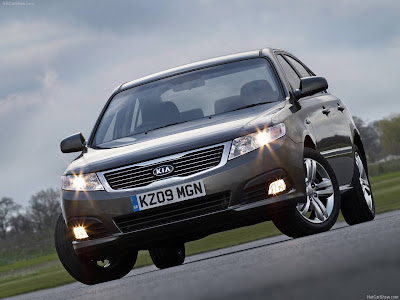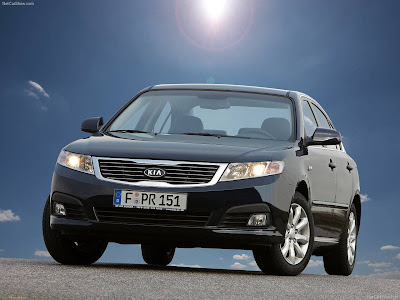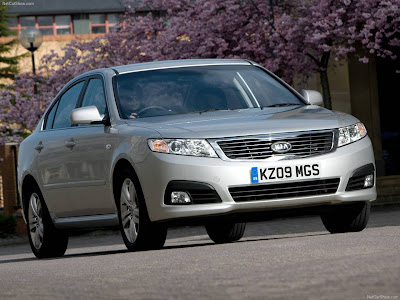




With upgraded state-of-the-art diesel power, European-standard ride and handling, modern and dynamic styling, top-level safety and low costs of ownership, the Kia Magentis has all that it takes to meet the expectations of private and fleet motorists.
It is a D-segment saloon that competes with the Ford Mondeo, Opel Insignia and Volkswagen Passat. Even with the gravitation of buyers to compact SUVs, MPVs and so-called premium-badge cars, this sector still accounts for well over a quarter of a million sales in the UK each year.
The 2009 Magentis is a development of the clever platform created to be shared with Kia Carens, the company's clever compact MPV. Carens offers buyers the choice of five or seven seats without the need for two cars of different length, the path rivals have been forced down. The platform allowed Kia designers to give Kia Magentis a dynamic stance that does justice to the way it drives, plus exactly the proportions they wanted - not only for style but also for safety and aerodynamic performance. There is, naturally, ample room for five passengers and their luggage.
The basis of the 2009 Kia Magentis is a modern, dynamic, European-influenced four-door saloon that successfully harmonises the flair of the new design face of Kia which has been developed by Kia's Chief Design Officer, Peter Schreyer.
The revised Kia Magentis has been given the 'Schreyer' styling treatment all round, most notably the new 'tiger nose' grille at the front, with a long sweeping, bold front bonnet edge which caps the grille and headlights. The car is 65 mm longer than the outgoing model, which gives a sleeker appearance.
Space, refinement, comfort and luxury are the hallmarks of life on board the Kia Magentis and these have been enhanced for the 2009 model. Kia recognises that many people who buy or drive D-segment cars spend long hours on the road, and though they expect a responsive and involving car to drive, they also value peace, quiet and comfort. The new Magentis delivers more of this, thanks to a completely revised suspension package and improved NVH characteristics.
It features seats and trim specifically developed for European tastes and driving styles. The seats have large side bolsters that provide more lateral support than those fitted in other markets - a concession to UK drivers' generally higher cornering speeds and the country's more twisty roads. They also have a longer cushion to provide greater under-thigh support.
Space is a necessity, not a luxury in D-segment cars. In the Kia Magentis, it is generous all round, supporting Kia's claims that this is a genuine five-person car. This has been achieved without resorting to the gargantuan lengths of some competitors, but through intelligent packaging solutions.
The Kia Magentis's safety credentials are underscored by a long list of standard features, including twin front, side and curtain airbags, active headrests on both front seats to prevent whiplash injury in nose-to-tail crashes, and Anti-lock Braking System (ABS), allowing the car to be steered and braked simultaneously without going out of control. Electronic Brakeforce Distribution (EBD) ensures the stopping power automatically goes to the wheels with most grip. And Electronic stability Control (ESC) and Traction Control (TC) are fitted as standard.
In order to simplify the range, there is only one version of the 2009 Magentis on sale in the UK, based on one high specification trim level, one efficient CRDi engine and a choice of two transmissions. The all-independent suspension has been revised delivering a more dynamic experience and with improved comfort, and allied to the latest electronic driver aids to minimise the risk of accidents. The revised Kia Magentis is right at home with its European competitors.
That is emphasised by Kia's decision to fit the upgraded, modern and efficient 147bhp 2.0-litre turbodiesel engine, as seen in the recently facelifted and European built Sportage. With sales to business 'user-choosers' so important in the D-segment and diesels by far the preferred choice because they reduce the amount of benefit-in-kind tax paid by owners, the Kia Magentis CRDi is proving to be hugely popular for its low running costs, refinement and performance. It is capable of upto 47.1 mpg (40.9 mpg for the automatic) when touring.
The 2009 Kia Magentis is now only available with the 2.0-litre CRDi power and a choice of six-speed manual and four-speed automatic transmissions. Diesel sales hold the majority for the Magentis so the 2.0-litre and 2.7-litre petrol derivatives have been dropped from the range.
With regards to trim levels, there is only now one, highly-specified model - the TR trim replaces the outgoing GS and LS specifications. The best attributes and equipment of previous Magentis models have been loaded into one, new and well appointed TR trim level which is equipped to a far higher level than many competitors. Cruise control with steering wheel mounted controls, full climate control with a cabin air filter, front and rear electric windows with auto-down function for the driver, electrically-adjustable heated door mirrors, variable intermittent wipers and automatic headlamps add to the comfort of, and minimse stress on, the person behind the wheel.
It looks as good as it drives
The basis of the 2009 Kia Magentis is a modern, dynamic, European-influenced four-door saloon that successfully harmonises the flair of the new design face of Kia which has been developed by Kia's Chief Design Officer, Peter Schreyer.
The styling has been given the 'Schreyer' treatment all round, most notably the new 'tiger nose' grille at the front, with a long sweeping, bold front bonnet edge which caps the grille and headlights. This is a design cue which has been seen on the international Kia Forte (Cerato) which has commenced sales in some markets in early 2009, and will be evident in the new Sorento, which was unveiled at the 2009 Seoul Motor Show.
Kia Magentis is a D-segment car that competes with the Ford Mondeo, Vauxhall Insignia and Volkswagen Passat. Even with the gravitation of buyers to compact SUVs, MPVs and so-called premium-badge cars, this sector still accounts for well over a quarter of a million sales in the UK each year.
The Magentis has clean, crisp lines free of unnecessary ornamentation and the new enhancements give it a more premium look and feel. Dynamic from any angle, emphasised by the voluminous front, the sporty yet stable rear links to the the strong profile with its sweeping C-pillar. The car is 65 mm longer than the outgoing model, which gives a sleeker appearance.
When designing the Magentis, Kia made a totally clean start that involved an all-new platform to be shared with the Carens, the company's clever compact MPV - the 2009 Kia Magentis builds on that package. The platform allowed Kia designers to give Magentis a dynamic stance that does justice to the way it drives, plus exactly the proportions they wanted - not only for style but also for safety and aerodynamic performance. There is, naturally, ample room for five passengers and their luggage.
The airflow over, around and underneath the car is aided by careful shaping of the nose, door mirrors, A-pillars and upper door frames, plus the improved tight panel fit which are a result of increased investment in the Hwasung plant where Kia Magentis is built. With a lip on the front bumper, a full cover beneath the engine bay and airflow deflectors ahead of the fuel tank, the drag coefficient is just 0.32.
The ethos that Peter Schreyer has brought to Kia is clear within the 2009 Kia Magentis. The front is dominated by the bold, wide tiger nose grille, flanked by sharp almost aggressive headlamps and underlined by a deep front bumper. The restyled, smooth and more sophisticated rear lamp clusters underline a more premium look for the Kia Magentis while a restyled bumper gives a solid appearance. The car sits on newly styled 17-inch alloy wheels as standard.
The new styling is in keeping with the aim of Kia Motors Corporation - to bring Kia to the forefront of vehicle design by making it a brand famous for good quality products that offer value and all in a design led package.
Spacious, safe and well-equipped
Space, refinement, comfort and luxury are the hallmarks of life on board the Kia Magentis. Kia recognises that many of the people who buy or drive D-segment cars spend long hours on the road, and though they expect a responsive and involving car to drive, they also value peace, quiet and comfort. The Kia Magentis delivers all round.
It features seats and trim specifically developed for European tastes and driving styles. The seats have large side bolsters that provide more lateral support than those fitted in other markets - a concession to UK drivers' generally higher cornering speeds and the country's more twisty roads. They also have a longer cushion to provide greater under-thigh support.
Space is a necessity, not a luxury in D-segment cars. In the Magentis, it is generous all round, supporting Kia's claims that this is a genuine five-person car. This has been achieved without resorting to the gargantuan lengths of some competitors. It has come about through intelligent packaging solutions that have also allowed Kia to create five- and seven-seat compact MPVs (the Carens) from the same platform.
In Kia Magentis, all five occupants enjoy a high hip point, giving a commanding view of the road. Rear passengers sit 25mm higher than those in front to ensure they also enjoy a view through the windscreen. Luggage capacity is an impressive 425 litres (500 litres with the seats down), and there are 60:40 split rear seats with fold-down backrests to permit extra-long loads to be carried.
The Kia Magentis's safety credentials are underscored by a long list of standard features, including twin front, side and curtain airbags and active headrests on both front seats to prevent whiplash injury in nose-to-tail crashes. All models come equipped with Electronic Stability Control (ESC), Anti-lock Braking System (ABS), Electronic Brakeforce Distribution (EBD), Brake Assist (BAS) and Traction Control (TC) provide the ultimate in accident-avoidance electronic driver support.
Anti-lock Braking System (ABS) allows drivers to maintain steering response and directional control even when braking heavily, minimising the risk of an accident. Electronic Brakeforce Distribution (EBD) adjusts the force applied to individual brakes as a further aid to directional stability.
Brake Assist (BAS) recognises when a driver is applying emergency braking and ensures maximum retardation to reduce stopping distances. Electronic Stability Control (ESC) prevents skids by comparing the car's course with that intended by the driver and applying the brakes to individual wheels, slowing the engine - or both - to keep it under control.
Should an accident be unavoidable, occupants are protected by a remarkably stiff and strong bodyshell and six airbags - twin front, side and curtains. The Magentis's side airbags are extra deep, protecting both the thorax and pelvis of front-seat occupants. The passenger side front airbag has an on-off switch so that a rear-facing child seat can be carried.
The interior design team made strenuous efforts to ensure the quality of the fittings is on a par with the best from Europe. Tight-fitting trim, soft-touch surfaces, logically laid-out controls and switches and a smart all-black interior with aluminium trim to give the new Kia Magentis an upmarket look and feel. A new and fresh looking three-barrel instrument binnacle is fitted to Kia Magentis for the first time.
Engines, gearboxes, suspension, steering and brakes
One engine, two transmissions, completely revised all-independent suspension and steering delivering more dynamic handling and a comfortable ride and the latest electronic driver aids to minimise the risk of accidents make the Magentis right at home with its European competitors.
That is particularly emphasised by Kia's new, modern and efficient 147 bhp 2.0-litre turbodiesel engine. With sales to business 'user-choosers' so important in the D-segment and diesels by far the preferred choice because they reduce the amount of benefit-in-kind tax paid by owners, the Kia Magentis CRDi is proving to be hugely popular for its low running costs, refinement and performance.
It is available with either a six-speed manual or a four-speed automatic gearbox, which offers the option of fully-automated shifts or sequential manual control.
Extensive weight-saving measures, with 60 per cent of the body (weight) formed from strong but comparatively light high-tensile steel, aid performance, economy and emissions. Weight-saving has been enhanced by the compact and lightweight front and rear suspension systems, which have the additional benefit of improving the new Magentis' dynamic behaviour.
Powertrain
The new 2.0-litre turbodiesel is a proven quantity, having been fitted to the recently facelifted and European built Sportage. The unit has been praised for its driving characteristics, thanks to the employment of Variable Geometry Turbo (VGT) first seen in the European designed, developed and engineered Kia cee'd CRDi engines. Smoother, more refined, torquey and clean, the new engine brings the not-insignificant additional benefit of lowering monthly company car tax bills for business users.
The CRDi engine is a single overhead camshaft, 1991cc, 16-valve four-cylinder unit featuring second-generation common-rail high-pressure fuel injection and electrically-actuated variable turbine geometry to ensure lively response throughout the rev band with clean emissions. A diesel particulate filter is fitted to trap the vast majority of the minute specks of soot contained within the exhaust gases.
The engine develops 147bhp at 4000rpm and 225lb/ft of torque all the way from 1800 to 2500rpm. Driving through the standard six-speed manual gearbox, it powers the new Kia Magentis from 0-62mph in 10.4 seconds and on to a maximum speed of 125mph. Combined fuel consumption is 47.1mpg, with CO2 emissions of 158g/km. This engine provides the Kia Magentis with an improved power, response, drivability and reduced emissions.
In terms of cash savings, the CO2 reductions are enough to drop the Kia Magentis down a category for VED for the automatic transmission. The manual reduces from 162 to 158 g/km whilst the automatic changes from 191 to 185 g/km, both representing real savings for car owners.
The automatic gearbox is an 'intelligent' unit with a dedicated transmission ECU to monitor a variety of parameters to guarantee smooth shifts as it adapts to individual driving styles. It also features Kia's Sport Mode system that allows the driver to exercise sequential manual shifting in place of fully-automatic operation. High top gear ratios ensure reduced fuel consumption and quieter cruising at high speeds.
Running gear
The Kia Magentis shares a platform that is also used by Kia's compact five- or seven-seat MPV, the Carens. It features fully-independent front and rear suspension systems designed to take advantage of the stiff body, long wheelbase and wide track. The 2009 Magentis has been further developed to deliver a more European-style of steering response, dynamics, road holding, ride comfort and braking.
To help with these aims the 2009 Kia Magentis has seen its spring stiffness increased by 20 per cent at the front and five per cent at the rear. The rear anti-roll bar has been thickened by 3 mm to help reduce understeer with a view to achieving a more neutral driving behaviour. The revised model has seen improvements to body control with retuned damper valves and new suspension top-mounts at each corner.
At the front, Kia has adopted the MacPherson strut layout favoured by the majority of D-segment contenders. Mounted on the same subframe that supports the powertrain, it provides optimum stability and ride comfort with good steering response.
Kia employs a compact transverse subframe to support a rear multi-link system with twin upper arms and long lower trailing arms, plus separate coil springs and dampers. The system is so tightly engineered (a significant percentage of the components are mounted within, or very close to, the interior space of the 46mm offset road wheels) that it has been called in-wheel multi-link. Taking advantage of the Magentis's rigid structure, it minimises body roll, reduces tyre-generated road noise and ensures negligible intrusion into the passenger or luggage compartments.
The hydraulically-operated rack and pinion steering system has been retuned throughout the system to offer better road feedback with 2.8 turns from lock-to-lock for a tight turning circle of 10.8 metres. It allows quick response and improved feedback on country roads without being over-sensitive for motorway driving. Every Kia Magentis comes with 17-inch alloys with Goodyear 215/50 VR rated tyres.
Refinement
The levels of noise, vibration and harshness (NVH) in the Magentis's cabin are particularly low, thanks to a studied programme of measures.
These include sound-proofing foam in hollow sections of the bodyshell; the use of front and rear subframes for mounting the suspension; a thick under-bonnet sound-absorbing pad; insulation pads on the cabin floor, in the door cavities and on the bulkhead between the engine bay and passenger cell; triple-layer rubber seals and weather strips around the doors and windows; and aerodynamically refined door mirror shrouds and mountings.
The revised Kia Magentis benefits from extra NVH insulation at the front and rear, thanks to the new suspension top mounts.
No comments:
Post a Comment